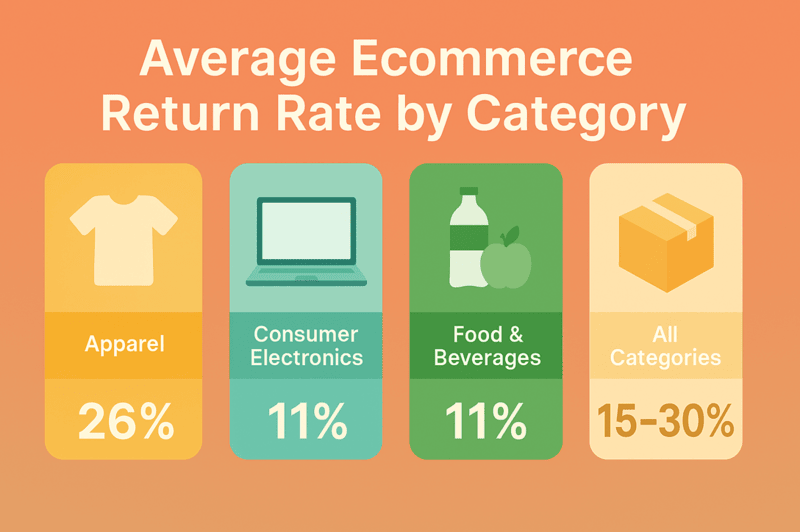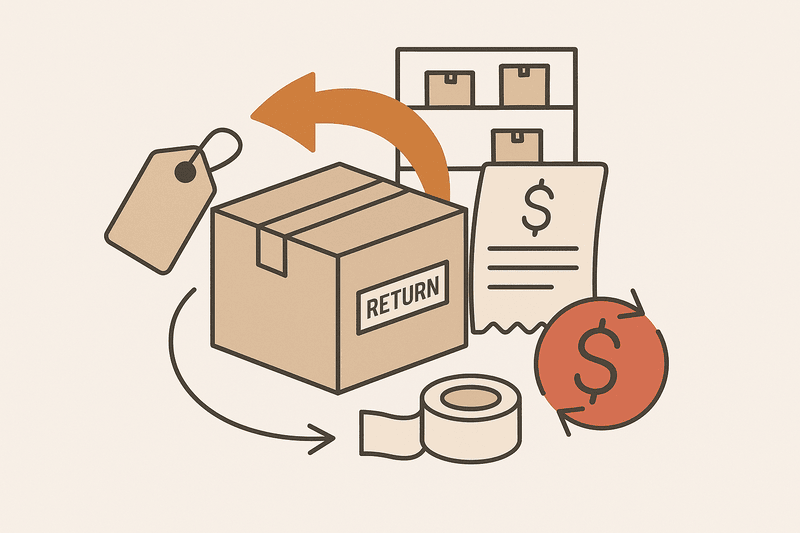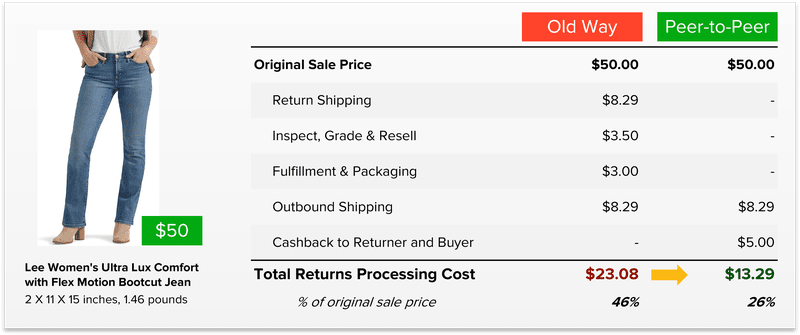Understanding the Average Ecommerce Return Rate: Key Insights and Tips

Last updated on April 16, 2025

In this article
 11 minutes
11 minutes
- Key Takeaways
- Understanding the Average Ecommerce Return Rate
- Factors Influencing Ecommerce Return Rates
- Ecommerce Return Rates by Product Category
- Return Rate Calculation
- The Costs of Ecommerce Returns
- Strategies to Reduce Return Rates
- Managing the Returns Process Effectively
- The Role of Customer Feedback in Reducing Returns
- Summary
- Frequently Asked Questions
The average ecommerce return rate falls between 15% and 30%. In this article, we explore the factors influencing return rates, variations across product categories, and effective strategies to reduce returns, helping businesses optimize operations and enhance customer satisfaction.
Key Takeaways
- Ecommerce return rates typically range from 15% to 30%, with holiday seasons often pushing that average higher, making understanding these patterns crucial for business strategy.
- Customer satisfaction hinges on product quality, accurate descriptions, and a hassle-free return process, which together help minimize returns and improve loyalty.
- Implementing dynamic sizing charts, detailed product descriptions, and effective return management can significantly reduce return rates and enhance the overall customer experience.
Understanding the Average Ecommerce Return Rate

Ecommerce return rates are vital for online retailers, reflecting customer satisfaction and impacting sales. Typically, these rates fall between 15% and 30%, with many businesses seeing figures around 20% to 30%. This range can benchmark your return metrics and pinpoint areas for improvement.
The holiday seasons, in particular, pose unique challenges that lead to even higher average return rates for both online and physical stores. This spike generally results from increased gift purchases and impulse buys, and analyzing return patterns and reasons can help ecommerce businesses refine operations to boost customer satisfaction prior to purchase and help prevent returns later.
Thus, understanding delicate return rate nuances allows ecommerce businesses to strategize more effectively and work to mitigate future losses. Improving product descriptions and streamlining return policies and processes, for example, can significantly lower return rates when implemented effectively.
Factors Influencing Ecommerce Return Rates
Various factors significantly influence ecommerce return rates, each contributing uniquely. High return rates often result from customer dissatisfaction and incorrect sizing. Categories like apparel and footwear have higher return rates due to sizing issues and customer preferences.
Seasonal spikes, especially during holidays, also affect return rates. Moreover, the returns management strategy itself has been shown to greatly affect return frequency. An easy return process can decrease return rates and enhance customer satisfaction simply by being flexible and uncomplicated. Recognizing these factors enables ecommerce businesses to develop targeted strategies to minimize returns.
Product Quality
When it comes to customer satisfaction and return rates, product quality is a big deal. Did you know that a whopping 81% of returns are because items are defective or damaged? That’s why having top-notch quality control is a must. Returns often happen due to poor quality control or shipping mishaps.
Plus, if the quality doesn’t match what customers expect, they’re likely to return it. Nearly 10% of people send items back because they feel they’re not getting their money’s worth. So, making sure you have accurate product descriptions and solid quality checks during manufacturing is key to meeting customer expectations and cutting down on returns.
Customer Expectations
When reality doesn’t match customer expectations, returns start to add up quickly. If product descriptions aren’t accurate, it can really shake customer trust and bump up return rates. Products that don’t live up to their descriptions can leave customers frustrated. It’s estimated that about 30% of returned electronics are perceived to either be the wrong item or simply not meet quality expectations.
Again, accurate product details are super important to get right because online shoppers must rely on this info when shopping for items sight unseen. Clear, detailed descriptions help avoid misunderstandings, which means fewer returns and happier, more loyal customers.
Ease of Return Processes
How easy it is to return something plays a big role in return rates. Simple and reliable returns make customers feel more confident and can actually reduce how often things are sent back. Half of ecommerce businesses offer free return shipping today. This commitment to easy and hassle-free returns boosts customer satisfaction and encourages people to shop with you again, especially when free returns are an option.
Ecommerce Return Rates by Product Category
Return rates can vary wildly depending on the product category, and each one comes with its own set of challenges and trends. Apparel, for example, often has the highest return rates, mainly because of sizing issues and different customer tastes. Consumer electronics, however, tend to have a lower return rate. Knowing these differences in consumer behavior helps ecommerce businesses craft strategies that tackle the specific challenges of each category.
Apparel
The apparel category is notorious for high return rates, averaging around 26% in D2C ecommerce brands, with some reporting as much as 33% or more. Fit issues are the main culprit cited by online shoppers, accounting for up to 70% of returns in this category, highlighting the need for accurate sizing info and dynamic sizing charts. Addressing these issues can make a big difference in cutting down return rates in the apparel category.
Consumer Electronics
Consumer electronics generally have a lower return rate compared to apparel, averaging about 11%. However, as mentioned previously, the category tends to have one of the highest rates of return for not meeting customer expectations (product not as described). Making sure you have accurate product descriptions and solid quality control can help reduce return rates in this category and enhance the overall customer experience.
Food and Beverages
The food and beverages category also has a return rate of about 11%, influenced by perishability and consumer preferences. Strategies like “returnless refunds” (aka “Keep It Returns”) can help manage returns effectively, improving customer experience while minimizing operational expenses and challenges.
Return Rate Calculation
The return rate for ecommerce is an important metric to monitor. Calculating your ecommerce return rate is straightforward yet essential for understanding return dynamics. Divide the number of returned items by total sales during that period, then multiply the result by 100. This formula provides a clear picture of your return rate as a percentage, helping to identify trends and areas for improvement.
An average return rate of 15–20% is generally acceptable for ecommerce businesses. A return rate below 10% indicates strong product quality and customer satisfaction, while rates exceeding 60% signal serious issues needing immediate attention.
The Costs of Ecommerce Returns

Ecommerce returns entail direct and indirect costs that significantly impact a business’s bottom line. Direct costs include return shipping fees, restocking charges, and product depreciation, ranging from 20% to 65% of the item’s original value. These costs can quickly accumulate, especially for businesses with high return rates.
Indirect costs include lost sales and customer loyalty issues, significantly affecting revenue and profitability, but they’re more difficult to quantify. Ecommerce returns are projected to grow substantially, with estimates suggesting a $1.4 trillion increase by 2025. Managing these costs in an ecommerce business is crucial for maintaining healthy profit margins and supporting growth.
Strategies to Reduce Return Rates
Reducing return rates requires a multifaceted approach addressing various aspects of the customer journey. Detailed product descriptions, enhanced product imagery, and dynamic sizing charts are effective strategies to minimize returns. These elements set accurate customer expectations and reduce the likelihood of returns.
Educating customers post-purchase is also key to reducing returns and providing an optimal experience. Implement effective strategies to answer questions and guide the user with product tips and tricks, which also serve to build customer loyalty.
Detailed Product Descriptions
Clear, detailed product descriptions are crucial for managing customer expectations and reducing return rates. Discrepancies in descriptions account for 64% of ecommerce returns, underscoring the importance of accuracy. Including specifics like ingredient labels and compatibility details are good examples.
Enhanced Product Imagery
High-quality images or interactive 3D tools also improve customer understanding before purchase, reducing returns by providing clear visual representations of products. Displaying multiple images from various angles aligns customer expectations and reduces surprises.
Best practices for enhanced imagery include high-resolution images and video demonstrations to showcase product features. These practices improve the online shopping experience and help reduce returns.
Implementing Dynamic Sizing Charts
Dynamic sizing charts help customers find the best size, improving fit and satisfaction. These charts recommend the best fit based on user input, considering personal measurements and preferences. Dynamic sizing charts are particularly useful for minimizing return rates in the apparel and footwear categories.
Managing the Returns Process Effectively
An effective returns process is crucial for maintaining customer satisfaction and loyalty. A clear return policy builds customer trust and influences future purchase decisions. Complicated policies harm loyalty, emphasizing the need to simplify return processes.
Utilizing returns management software streamlines the process and enhances customer service, making returns easier for customers and businesses alike. Encouraging exchanges instead of refunds protects profit margins and maintains positive cash flow.
Automating Returns
Automating the returns process decreases handling costs and improves efficiency. Return management applications can enhance efficiency significantly. For instance, AfterShip claims a 50% reduction in return processing time for ecommerce businesses through effective ecommerce returns management and reverse logistics.
Returns automation streamlines the process, improving customer satisfaction and operational efficiency. It simplifies returns for customers and management for businesses.
Offering Store Credit
Offering store credit retains revenue and encourages future purchases. AfterShip reports a 50% increase in revenue retention through exchanges when store credit is offered. Try offering exchanges for a longer period than the returns window; this strategy retains revenue while providing customers flexibility.
A returns automation platform like Loop offers instant refunds or store credit, encouraging customers to exchange their returned product within the return window. This approach builds customer loyalty and ensures a positive return experience.
A peer-to-peer returns platform like Cahoot helps resell returned items faster while eliminating much of the cost to the business. The savings can be shared with key stakeholders, such as offering additional store credit for customers returning items in new condition, while offering the items at a discount as “open box” for sustainability and thrift-focused shoppers.
Keeping Customers Informed
One thing is clear: updating customers during the return process, whatever the outcome, significantly boosts the likelihood of future repeat purchases. Automated notifications—via email or SMS—with shipment tracking updates, order arrival at the warehouse, and status of refund, exchange, or store credit all demonstrate a commitment to transparency and keeping customers informed.
Such communication builds customer trust and enhances the overall shopping experience.
The Role of Customer Feedback in Reducing Returns
Actively seeking customer feedback post-refund gathers insights on customers’ return experiences. Understanding the decisive reasons and encouraging people to be forthcoming enables businesses to implement effective solutions and improve product and service offerings. Analyzing products with high return rates helps make informed decisions about product catalogs that can potentially be used as a competitive advantage. So leverage customer feedback to enhance customer experience and reduce return rates.
Summary
Understanding the average ecommerce return rate and actively working to minimize yours involves mastering the intricate factors that influence returns, from product quality to customer expectations and the ease of return processes. Each product category presents its unique challenges, and tailored strategies are essential for effectively managing returns. Reducing return rates starts with detailed product descriptions, enhanced product imagery, and dynamic sizing charts, which set accurate customer expectations prior to clicking the buy button.
Effectively managing the returns process is equally crucial. Automating returns, offering store credit, and keeping customers informed can streamline operations and build long-term loyalty. By actively seeking and leveraging customer feedback, ecommerce businesses can continuously improve their offerings and minimize returns. Armed with these strategies, businesses can turn returns from a costly challenge into an opportunity for growth and enhanced customer relationships.
Frequently Asked Questions
What is a good return rate for an ecommerce business?
A return rate of 15–20% is pretty standard for ecommerce, while under 10% is a win. If you’re seeing over 60%, though, you might want to dig into what’s going wrong.
How can detailed product descriptions help reduce return rates?
Having detailed product descriptions can seriously cut down on return rates by setting clear expectations for customers. When they know exactly what they’re getting, they’re less likely to be disappointed and send it back.
What are the benefits of offering store credit instead of refunds?
Offering store credit instead of refunds keeps your revenue intact and encourages customers to come back for more. Plus, it helps build loyalty and makes the return experience better for everyone.
Why is keeping customers informed during the return process important?
Keeping customers informed during the return process is crucial because it enhances their experience and builds trust, making them more likely to shop with you again. Regular updates, like automated notifications on return statuses, can really make a difference.
How can customer feedback help reduce return rates?
Customer feedback is key in figuring out why returns happen, which helps businesses make improvements and boost the customer experience. By addressing those issues, companies can significantly reduce return rates.

Up to 64% Lower Returns Processing Cost


